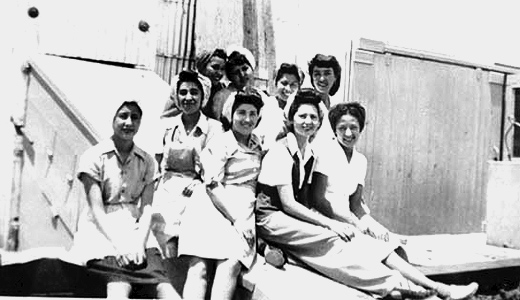
The history of a place like Southern California, Los Angeles in particular, often baffles those who approach it: multiple waves of migration from every corner of the globe; a genuine, nearly 170 year-long identity crisis with its neighbor to the south; and, at best, an ambiguous cultural relationship with the 3,000-mile-away coast where the United States took shape.
Too often the present moment takes on the feeling that it is all that has ever existed. Los Angeles appeared on North America as a postmodern, blighted urban sprawl, always has been that way, and always will be. Angelenos, likewise, are an ahistorical type. They have no connection to the formation of Los Angeles; rather, Angelenos are simply those who find themselves in Los Angeles.
This dynamic repeats throughout the United States on a national scale. What does the contemporary American have to say or do about the genocides of indigenous peoples and the Transatlantic Slave Trade? The contemporary American does not desire to be taken to account, for they are innocent; they have simply found themselves living in this place called the United States of America.
By no means does this represent some pernicious denial of past atrocities, but rather a passive fatalism which often goes unexamined, misunderstood, and unaddressed. Luckily for the residents of Los Angeles, La Plaza de Cultura y Artes, a museum dedicated to the Mexican-American history and culture of the city, has taken to task on a local scale this national endemic of historical consciousness, and the prognosis proves uplifting.
LA Starts Here!
According to its mission statement, La Plaza de Cultura y Artes sets out “to celebrate and cultivate an appreciation for the enduring and evolving influence of Mexican and Mexican-American culture, with a specific focus upon the unique Mexican-American experience in Los Angeles and Southern California.” Located in the historic center of the Pueblo of Los Angeles, the museum does just that.
One cannot visit the space without becoming aware of the history underground and around. Standing at the end of colorful Olvera Street, itself lamentably dismissed and ignored as touristy kitsch by many locals, the museum’s neighbor across the street is the famous Pico House, once the most well-known hotel in Southern California. The firebrand radical Emma Goldman once lectured at the Italian Hall right around the corner. The location itself asserts the presence of History before one has even entered the building.
The bilingual centerpiece of the museum, “LA Starts Here!,” first establishes the thesis that Los Angeles is a Mexican-American place before proceeding to provide the historical evidence establishing that narrative. Regrettably, the exhibit fails to provide a robust understanding of the indigenous peoples who occupied what came to be Los Angeles. History only becomes significant with the arrival of Spaniards venturing north from Mexico and their foundation of a secular township.
The exhibit proceeds to illustrate the separation from the Spanish crown, implying the beginning of Los Angeles as a Mexican place. Californio artifacts provide a quick glimpse into life in this Mexican place, yet 1848 arrives quick as ever with the coming of the Americans. Notably, bilingual subtitles refer to what almost sounds like two different conflicts. There is the Mexican-American War right alongside Intervención estadounidense en México, or, better translated, The American Invasion of Mexico. That cross-lingual tension gets right to the heart of the history of the place the museum presents. Los Angeles is neither Mexican nor American but Mexican-American.
Next come presentations of historical tropes which appear more topical to contemporary American visitors: Immigration and Labor. The former provides nothing unsettling or novel to anyone even superficially familiar with this place at the turn of the 20th century, leaving the vague, banal impression that a lot of people come here from a lot of exotic places.
The portion of the exhibit dedicated to labor offers a snapshot of working people’s lives and their political struggles during the Great Depression era. Focusing on Mexican-American women workers at the fruit canneries of Southern California, artifacts such as a typical uniform and wage-card offer a physical representation of these women workers, while mention of their strike in 1941 suggests the vitality of their activism. As in the preceding portion, one can appreciate the mention of oft-forgotten laborers and their struggles while still walking away with a vague impression of a generic, non-specific significance. The exhibit ends after overviews of the darker histories surrounding redlining and deportation throughout Southern California.
Community engagement: Cannery Women, Cannery Lives
But the story does not end with the exhibit. True to its goals to serve as not merely a museum but also a cultural center, La Plaza hosted Professor Vicki Ruiz of the University of California Irvine last Thursday to lecture on her seminal work that informed the exhibit, Cannery Women, Cannery Lives: Mexican Women, Unionization, and the California Food Processing Industry, 1930-1950. Forty people gathered to hear this intimate, scholarly presentation of labor history in a private meeting room on the fourth floor with free public admission.
Professor Ruiz engaged the audience with her personal stories of interviewing Luisa Moreno, a “living legend” in the eyes of young Ruiz, creating a direct, human bridge connecting the audience at La Plaza with the labor struggles headed by Moreno during the Great Depression. Ruiz began her lecture suggesting audience members think of the historical subjects as “actual women coming of age in Los Angeles,” and proceeded to pepper her lecture with humanistic flourishes. Unions not only served to generically better the lives of working women but also offered a social space for self-actualization. Ruiz brought to life the women workers represented in the exhibit by a uniform and wage-card.
Finally, Professor Ruiz’s lecture linked the local narrative with wider political trends with her regular references to the infamous Communist Party USA of the Great Depression. Legendary female communists such as Dorothy Ray Healy and Luisa Moreno herself played foundational roles in leading and organizing these incipient efforts at unionization. The typical Stalinist veneer associated with this group dissipated when Professor Ruiz laughingly quipped, “They were good organizers, but bad commies.” In Ruiz’s telling of this Mexican-American story, all are included.
Revitalizing opportunities at La Plaza
During the Q&A session following the lecture, the issue of other minorities came up. During the lecture, Professor Ruiz alluded to a large cohort of Russian Jewish women who worked alongside Mexican-American women. When asked to expound on these women and their relationships with coworkers, Professor Ruiz sadly admitted that she couldn’t find the requisite documents and data to provide a portrait of those women. Through no fault of Professor Ruiz’s, one might have left that lecture thinking Cannery Women were singularly Mexican-American.
Yet by no means must those women remain on the margins, and this gets at the heart of both La Plaza’s mission as well as the efforts of those like Professor Ruiz. La Plaza establishes the Mexican-American history as foundational to Los Angeles, but, in contrast to past efforts, this history leaves itself open-ended. Professor Ruiz and La Plaza suggest that the Mexican-American history allows room for Russian Jewish women workers, and in no way excludes them. History, however conceived, must permit room for every human story lest it become exclusive and a tool of dehumanization. No coincidence, then, that during Professor Ruiz’s introduction, patrons were reminded that at La Plaza, “We collect stories.”
Efforts like those made by institutions like La Plaza challenge how the public understands history. More than that, La Plaza challenges the possibilities of a museum, blending together a community center with more traditional museum styles. Though imperfect as a museum, La Plaza points towards the future of public history and community engagement, and ought to serve as a model for local responses to nationally endemic amnesia. A more perfect union can and will only emerge one community at a time.
Photo: Mexican-American women cannery workers on lunch break outside the Southern California Fish Corporation, 1947. | San Pedro History Project / Los Angeles Public Library







